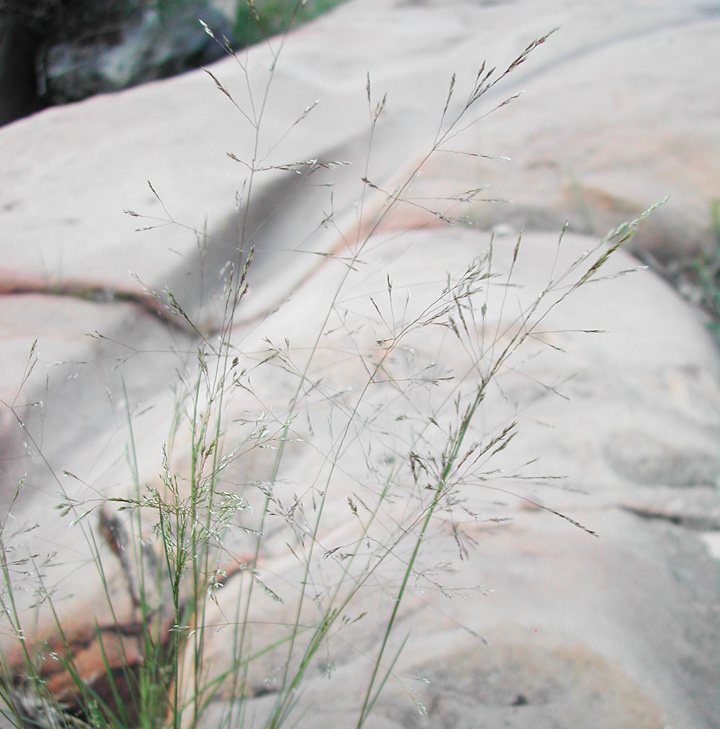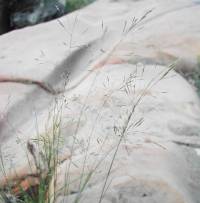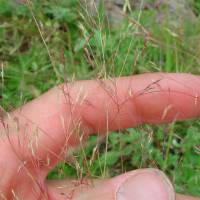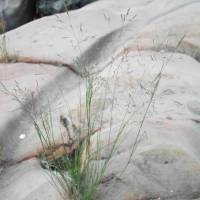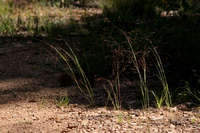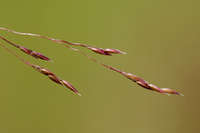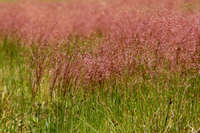Perennials, Terrestrial, not aquatic, Stems nodes swollen or brittle, Stems erect or ascending, Stems caespitose, tufted, or clustered, Stems terete, round in cross section, or polygonal, Stem internodes hollow, Stems with inflorescence less than 1 m tall, Stems, culms, or scapes exceeding basal leaves, Leaves mostly basal, below middle of stem, Leaves conspicuously 2-ranked, distichous, Leaves sheathing at base, Leaf sheath mostly open, or loose, Leaf sheath smooth, glabrous, Leaf sheath and blade differentiated, Leaf blades linear, Leaf blades very narrow or filiform, less than 2 mm wide, Leaf blades 2-10 mm wide, Leaf blades mostly flat, Leaf blade margins folded, involute, or conduplicate, Leaf blades mostly glabrous, Leaf blades scabrous, roughened, or wrinkled, Ligule present, Ligule an unfringed eciliate membrane, Inflorescence terminal, Inflorescence an open panicle, openly paniculat e, branches spreading, Inflorescence solitary, with 1 spike, fascicle, glomerule, head, or cluster per stem or culm, Inflorescence branches more than 10 to numerous, Lower panicle branches whorled, Flowers bisexual, Spikelets laterally compressed, Spikelet less than 3 mm wide, Spikelets with 1 fertile floret, Spikelets solitary at rachis nodes, Spikelets all alike and fertille, Spikelets bisexual, Spikelets disarticulating above the glumes, glumes persistent, Spikelets disarticulating beneath or between the florets, Entire inflorescence falling intact, as a tumbleweed, Rachilla or pedicel glabrous, Glumes present, empty bracts, Glumes 2 clearly present, Glumes equal or subequal, Glumes equal to or longer than adjacent lemma, Glume equal to or longer than spikelet, Glumes 1 nerved, Lemmas thin, chartaceous, hyaline, cartilaginous, or membranous, Lemma 5-7 nerved, Lemma glabrous, Lemma apex truncate, rounded, or obtuse, Lemma awnless, Lemma margins thin, lying flat, Lemma stra ight, Stamens 3, Styles 2-fid, deeply 2-branched, Stigmas 2, Fruit - caryopsis, Caryopsis ellipsoid, longitudinally grooved, hilum long-linear.
In low sandy and mucky soils in the northern counties. This species very much resembles the next one but it is separated from it by its larger size, its broader and flat cauline leaves, larger panicle, longer-pedicelled spikelets, longer spikelets, longer anthers, its later flowering season, and its northern range. This species flowers, on the whole, at least a half month later than the next one [Agrostis hiemalis].
Indiana Coefficient of Conservatism: C = 5
Wetland Indicator Status: FAC
Common Name: rough bentgrass
Duration: Perennial
Nativity: Native
Lifeform: Graminoid
General: Tufted perennial or annual, neither rhizomatous or stoloniferous with erect stems 15-90 cm, 1-3 nodes, sheaths smooth or sometimes minutely roughened.
Vegetative: Blades 4-14 cm long, 1-2 mm wide, basal blades involute, cauline blades flat; ligules 0.5-5 mm, dorsal surfaces scabrous, apices usually rounded, sometimes truncate, erose-ciliate.
Inflorescence: Broadly ovate panicles 8-25 cm long, 0.5-20 cm wide, often nearly as wide as long, diffuse, whole panicle often detaching at the base at maturity, exserted from upper sheaths, lowest node with 2-7 branches; branches scabrous, capillary, flexible and wide spreading, spikelets distant, not crowded, lower branches 4-12 cm; spikelets lanceolate, greenish purple to purple at maturity, disarticulating above the glume; unequal glumes 1.5-3.5 mm, lanceolate, keels scabrous toward the acuminate apices; lemmas scabrous to minutely roughened, unawned or awned from below midlength, awns 0.5-3 mm, geniculate or straight.
Ecology: Found in meadows, moist seeps and along streams or lakes from 5,000-9,500 ft (1524-2896 m); flowers April-October.
Notes: This is variable species, with awned and unawned plants often occurring together. Our specimens of this plant are often with broader leaves than elsewhere. The open diffuse panicle has acuminate glumes and a scabrous keel.
Ethnobotany: Unknown
Etymology: Agrostis is from the Latin and Greek names for a type of grass, from Greek agron or agros, field or pasture, while scabra comes from the Latin scaber meaning rough or scurfy.
Synonyms: Numerous, see Tropicos
Editor: SBuckley, 2010
Blooming later, June to November; spikelets more loosely arranged, the pedicels 0.5-5 (avg 2) mm; glumes 2-3 mm; Lab. to Alas., s. to Ga., Tex., and Mex. (A. scabra; A. h. var. tenuis)
Gleason, Henry A. & Cronquist, Arthur J. 1991. Manual of vascular plants of northeastern United States and adjacent Canada. lxxv + 910 pp.
©The New York Botanical Garden. All rights reserved. Used by permission.


